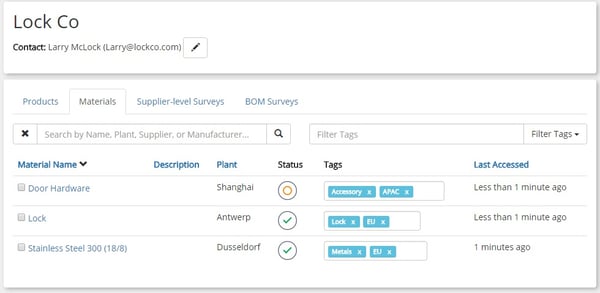 You’ve put together your team to initiate or revitalize your commitment to materials health and product transparency. You’ve engaged your suppliers and procurement team to guarantee a collaborative effort.
You’ve put together your team to initiate or revitalize your commitment to materials health and product transparency. You’ve engaged your suppliers and procurement team to guarantee a collaborative effort.
With a large product portfolio, how do you organize your products, materials and supply chain data in a coherent way to drive meaningful change?
Most likely, your R&D team, procurement team, and suppliers all organize their data in incompatible ways. To effectively implement your product transparency program and drive change, it's imperative to have accurate data. Quantities are often managed differently with materials and suppliers versus with products and customers. Keeping these two straight and knowing how they relate will solve lots of your data management issues!
Here’s a simple framework to start thinking about how to organize your data:
- Products – What you design and sell (Often a Bill of Materials or BOM)
- Materials – What you make or buy (aka parts, components, formulations)
- Substances – The basic chemical units that make up your Products and Materials
- Quantities – How much of a substance is in a product or material

Lastly, you need to decide on data requirements. Do you need to collect substance data down to 100 ppm or is 1000 ppm ok? Do you need your suppliers to disclose every substance or can they mask the names and simply provide you with the hazard screening results? (tip: there will be suppliers who won’t provide details on proprietary substances, but would provide the screening results.
To meet your goals, this is often a great compromise). Drafting ideal requirements and minimum requirements for data quality will help you structure your data needs, and expectations. It will also help make your communications with suppliers more consistent.
Now that you understand what type of data you need, you can begin the process of mapping existing data to your internal list of regulations or use a system like Toxnot. We help you upload your data into customizable templates. Bill of Materials data from your internal systems will generally populate your product’s data fields. Information collected through supplier questionnaires will populate your materials data.
Within Toxot, you may also assign custom tags to Products and Materials, to make it easier to organize and filter your data:


While no large company is completely consistent in their product data management, having a data framework to target will greatly improve your success in organizing data to understand your chemical footprint. What are some tips you can share to help others succeed with organizing data?
